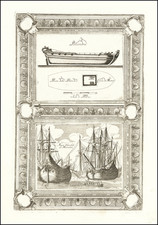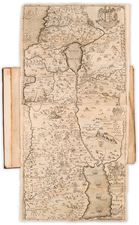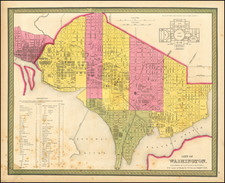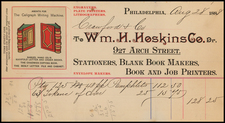The Washington DC Commissioner of Public Buildings Reports To Jeremiah Johnson on the Costs of Reconstruction of The White House, Capitol and other Official Buildings
Interesting letter and transmittal envelope written by Joseph Elgar, the Washington DC Commissioner of Public Buildings, to Massachusetts Congressman Jeremiah Nelson (1769-1838), summarizing the costs of reconstruction of the major buildings in Washington DC, including the White House (referred to in the letter as the President's House), Capitol Building, Executive Offices (Treasury and Navy), and State War Offices, as well as revenues generated from the "Sales of Lots in Washington City belonging to the U.S. States," value of unsold land, and donations from Virginia and Maryland for the construction of public buildings.
From 1821 to 1825, Jeremiah Nelson served as Chairman of the Committee on Expenditures on Public Buildings during the Seventeenth and Eighteenth Congresses. In this role, Nelson oversaw the allocation and spending of funds for the Capitol's reconstruction and other public buildings.
The pairing of the letter and transmittal "envelope" include a curious anomaly. The envelope is dated January 15, 1824 and transmits the accounting for the year 1823. However, the letter is dated February 15, 1825. It seems likely that the pair is in fact mismatched.
The Destruction of Washington D.C. and Its Rebuilding Post-War of 1812
In retaliation for American attacks on York, British forces invaded Washington D.C., intending to strike a decisive blow against the fledgling nation's government. They set fire to the White House, the Capitol, and other government buildings, leaving behind scorched shells. The fires consumed much of the Capitol's North and South wings, including the original House and Senate chambers. A sudden rainstorm prevented total destruction, yet the damage was severe.
The immediate restoration efforts focused on the White House, with architect James Hoban, who had originally designed the mansion, returning to lead the project. Hoban and his team took nearly three years to restore the structure, focusing on rebuilding the damaged walls and restoring intricate stone ornaments. This restoration was completed in 1817, allowing President James Monroe to take residence. In the present letter, Elgar notes that the original cost to build the White House was $333,207 and the cost to rebuild was $276,700.
The rebuilding of the Capitol was similarly extensive, starting in 1815. The task fell initially to Benjamin Henry Latrobe, who had previously overseen the Capitol's construction and returned to lead the restoration. Latrobe restored the old House and Senate Chambers, then commenced on the North and South wings. However, due to interference from Commissioner of Public Buildings Samuel Lane and President Monroe, Latrobe resigned in November 1817.
Charles Bulfinch, a prominent Boston architect, succeeded Latrobe in 1818. Bulfinch focused on completing the restoration of the North and South wings, making the Supreme Court, House, and Senate chambers usable by 1819. In 1822, Joseph Elgar became the new Commissioner of Public Buildings, overseeing Bulfinch's ongoing work. Bulfinch then undertook the design and construction of the Capitol Building's central section, including a copper-covered wooden dome. This section was completed in 1826, allowing Bulfinch to turn his attention to the Capitol's decoration and landscaping. His work culminated in 1829, after which his position with the government was terminated.
As of the end of 1824, Elgar's letter notes that the Capitol Building Wings was originally $788,071 and the cost to rebuild was $687,126, with the ongoing expansion of the Centre Building of the Capitol to date costing $728,000, with an estimated $80,000 to complete the work.
Joseph Elgar
Joseph Elgar, Jr., was likely born between 1772 and 1784. By 1807, he had established himself as a surveyor in Montgomery County, Maryland, later transitioning to a clerical role under Samuel Lane, the commissioner of public buildings for the District of Columbia. Benjamin H. Latrobe, who had a contentious relationship with Lane, disparaged Elgar in 1816 as "a Schoolmaster, and Land surveyor," reflecting the professional tensions of the time. The following year, Elgar replaced Latrobe as the surveyor of Washington after Lane forced Latrobe out of office. Upon Lane's death in 1822, Elgar succeeded him as commissioner of public buildings, a position he held until 1834.











![[ Lung Disease Epidemiology Map ] Map of Washington and Georgetown](https://storage.googleapis.com/raremaps/img/small/98983.jpg)




